By Joyce Zheng
PROJECT TITLE: Ocean Plastic Cage

PROJECT STATEMENT:
From the surface to the depths of the ocean — it is plastic. Plastic surrounds the dolphins and turns them into white foams, under the iceberg is the graveyard of plastic and whales, while fish nets twine their bodies, leaving no place for them to breathe. When will they all become transparent and escape from the plastic cage?
RESEARCH
I have conducted a few research in the art area. At first, I was looking through the “trash accessories”, like the pictures I show below.
Necklace of plastic, decorated with large flowers and leaves (2)

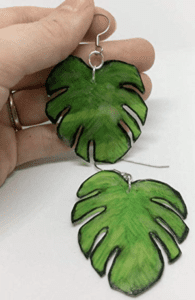


Source: https://www.pinterest.com/pin/211458144988843963/



These trash accessories look great, and inspired by the first necklace, I decided to use laser cut to create transparent ocean animals as components in my accessories. But I want to use more plastic in my project, so the materials in these accessories don’t match mine. What’s more, they look more like trash instead of accessories. How to transform trash into something that doesn’t look trash proves to be a problem. So I did some research on contemporary jewelry, also my jewelry.

Source: http://lucyclaregibson.com/jewellery
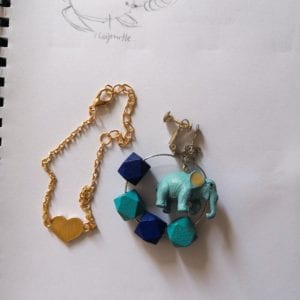
My Accessories
From the beginning of the design, I have decided to make a set of accessories. But I want them to be easy to wear, so I chose the type of metal chains that people will use in daily lives as the frame. But for the bracelet, inspired by a kind of bracelet that was popular in China, I tried to use the cables as the frame. Though finally, the bracelet doesn’t match the earrings and necklace, my initial aim was to make the kinds of materials to be as variable as possible.

SIGNIFICANCE
Although the style of the necklace is a bit exaggerated, it does not fit well with daily collocation, as wearable accessories, the meaning of the earrings can be spread when people wear them in daily lives, especially when someone asks you where you can get the earrings/what’s the meaning behind it.
For the project itself, the components of different animals are obvious: dolphins, sea turtles, and whales. According to WWF, whales are ENDANGERED. Few as 300 North Atlantic right whales remain; other species vary 10,000-90,000. The Irrawaddy dolphin is VULNERABLE, and according to WWF Hong Kong, The population inhabiting the Pearl River Estuary, including Hong Kong, is believed to number around 2,500 individuals. During the past few years, there has been a worrisome decrease in the number of young dolphins sighted in Hong Kong waters. Sea Turtles are VULNERABLE too, since “Human activities have tipped the scales against the survival of these ancient mariners. Nearly all species of sea turtle are classified as Endangered. Slaughtered for their eggs, meat, skin, and shells, sea turtles suffer from poaching and over-exploitation. They also face habitat destruction and accidental capture in fishing gear. Climate change has an impact on turtle nesting sites. It alters sand temperatures, which then affects the sex of hatchlings.”
For the design of the earrings, between fishnets and cans, there are big white dolphins that look like white foam. With the pollution of different kinds of plastic, one day there will only be plastic dolphin bodies in the ocean rather than the cute spirits who could save humans. The transparent small dolphin is a wish that there will be one day when the ocean becomes clean and all the dolphins, all the ocean animals who are trapped in the plastic cage can be free again.


My Earrings
For the necklace, the plastic silver wave represents that the waves you see may already become plastic trash, and the bottom of the shape of an iceberg is all plastic. This does not only mean that from the surface to the depths of the ocean is all filled with plastic trash, but also that the plastic trash we have already seen is only the tip of the iceberg. Some of my inspirations come from the posters below.



My Necklace
Though my bracelet was not in the final exhibition, how it looks reflects a picture that has been spread widely. The transparent turtle’s head and tails are pierced by the cables, which indicates that this species is becoming extinct due to plastic pollution.

My Bracelet
DESIGN & PRODUCTION
My project is based on the theme of Marine animals, so the first thing I have considered is how to make those animals. Since I want them to be part of accessories, they need to be good looking at the same time. Therefore I chose laser cut acrylic to create those components. I searched about pictures of whales, dolphins, and turtles and draw some sketches about the design. However, I met a lot of problems when laser cut the animals. The first is that the initial size is too small and the material of acrylic is easy to break, so many parts melted together and it cannot be used. I scaled up the size of the component, and make the engraving part stronger so that the pattern on it more clear. Nevertheless, the transparent material makes it hard to be seen, so later I added the white dolphin and change the color of whales into bluish-grey. These two colors also indicate that the ocean animals are being seriously polluted by plastic and other trash in the ocean.


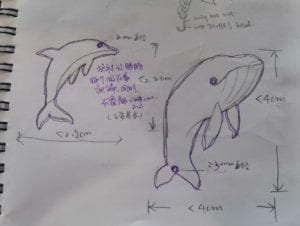
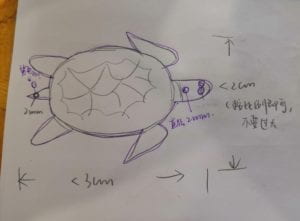
Sketches
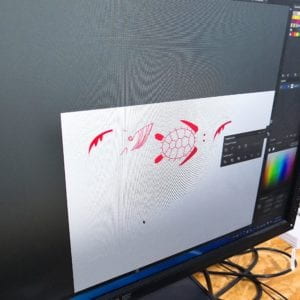
Design of the animals
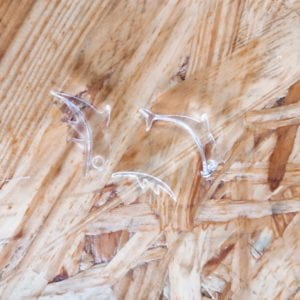




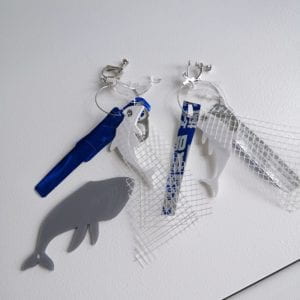
Laser-cut and some finished and defective products
I also started preparing other materials for my project. Since what pollutes the ocean is mainly plastic, I used plastic as my main material. My mother sent me some window screens leftover from home decoration, which looks really like fishnets and is used a lot in my project. What’s more, she also sent me the left cables and blue cans, whose different parts, like the rings and bodies, are used in my project. The ring-pull can is also one of the main trash that pollutes the beaches and the ocean.


Materials preparation
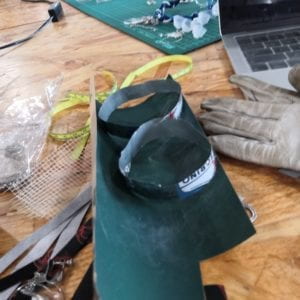
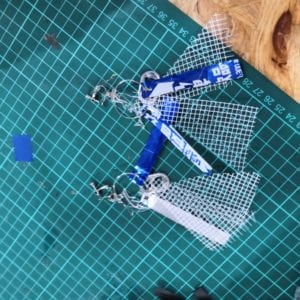
The use of cans and fishnets
For the necklace, inspired by the shining plastic leaves necklace, I decided to make a large piece of all kinds of plastic melted together as the background under the whale and the iceberg underneath it. I used the plastic-melting machine to stick all the blue plastic pieces I have collected and made. I also added some plastic pieces cut from the dumplings box, which looks like nylon fish cages people use to catch super small fishes.
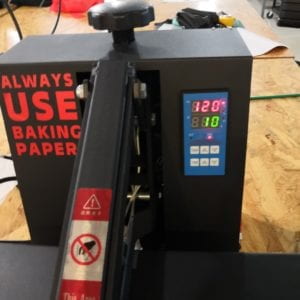
Plastic being melted
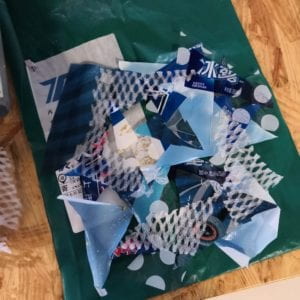
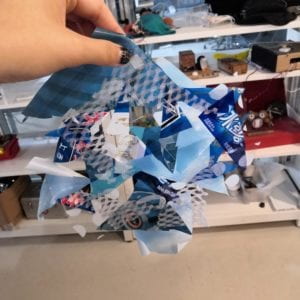

Plastic melted together

Design of the fish cage


Figuring out ways of connecting them
However, it turns out that the melted big plastic piece looks messy and likes a real piece of trash. Thus, I cut them into a triangle and glue them with the dark-blue plastic bag which has also been cut into a triangle shape, more like a deeper layer of the fishnet layer. I also added the inner shining side of the dark-blue plastic bag to show the wave on the surface of the ocean, also as a decoration.

Cutting out the triangle and glue the two parts together
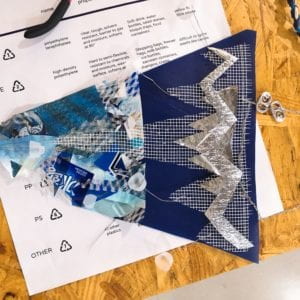
Adding the silver wave in the above

Adding the bluish-grey whales at the top layer
From the beginning, I decided to make a set of accessories, so it includes a bracelet. I choose the cables as the materials since it is a good frame. However, I met some problems gluing them together. I twined them together tightly and then glue it, twisted the wire to make sure it can go through the hole on the sea turtle without breaking it.

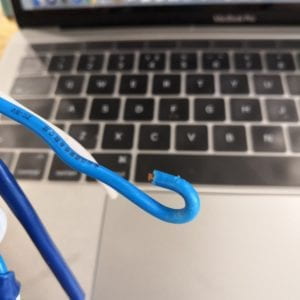

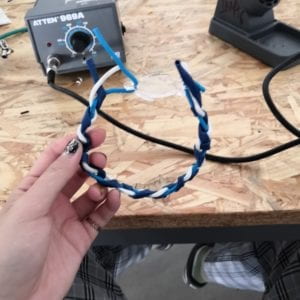


It looks good and it is one of my favorite designs. However, cables are not one of the main plastic pollutions in the sea and it does not match the necklace and earrings. It is great, but it is independent. I consider using the plastic straw and twine them together as the frame in the future. That is why it is not added to the final exhibition.
CONCLUSIONS:
When will people realize that ocean animals are becoming extinct because of the plastic trash they have thrown into the sea? By designing a set of accessories of earrings and necklaces, I want to illustrate the ocean animals represented by dolphins and whales have been suffering the plastic pollution in the ocean severely. The white foam body of dolphin surrounded by different kinds of plastic, escaping transparent soul of the dolphin, depressed color of the whale, mountains of rubbish under the icebergs — we are already killing these animals in person, how can this be solved?
The biggest difficulty I have met is how to fit those animals into the accessories since they are the key parts of my project. I designed with the precise size of the holes and animal bodies, but it turned out that they cannot be that small because they will be melted when being cut by laser. Additionally, I chose to use transparent plastic at first so they are hard to be found, which makes the subject less obvious. I did 4-5 times of laser cut to achieve the final effect of my project.
I have learned a lot from the project, one is how to use the laser cut to achieve the result I want. Second is the use of different plastic materials, for instance, cans and fishnets are harder, while plastic bags are softer and super easily to be melted, the inner side of some insulated plastic bags is silver and are great decorations, some thick cables are super hard to be twisted and stay at a fixed position. The most important thing I have learned is that when making projects expressing a certain theme, the related elements (no matter the materials or the way it is created) must be obvious and explicit enough so that people can notice and understand them.
For future improvements, I would like to add the bracelet to the set of accessories. I am thinking about a better frame of the bracelet, for instance, the plastic straw or maybe the nylon ropes. Then I can add some plastic pieces on the frame, so it will look more matchable with the necklace and earrings.
Accessories are just a small way to raise people’s awareness. The ocean animals are becoming extinct even at a twice speed than land animals. “These impacts are already happening. It’s not some abstract future problem.” To prevent those cute and intelligent ocean animals from being extinct, the road ahead really has a long and heavy.
References:
http://www.takepart.com/article/2015/12/02/cleaning-beach-taking-away-trash-cans
https://www.theatlantic.com/science/archive/2016/07/how-lasers-can-help-clean-up-beach-trash/490952/
https://www.worldwildlife.org/species/whale#
https://www.wwf.org.hk/en/reslib/species/chiwhitedolphin/
https://www.worldwildlife.org/species/sea-turtle#
https://sailhawaii.com/what-can-we-do-to-help-wildlife-cut-plastic-rings/
Special thanks to Marcela Godoy who helped me so much during the process of making the project and the make of the installation model frame.
Leave a Reply